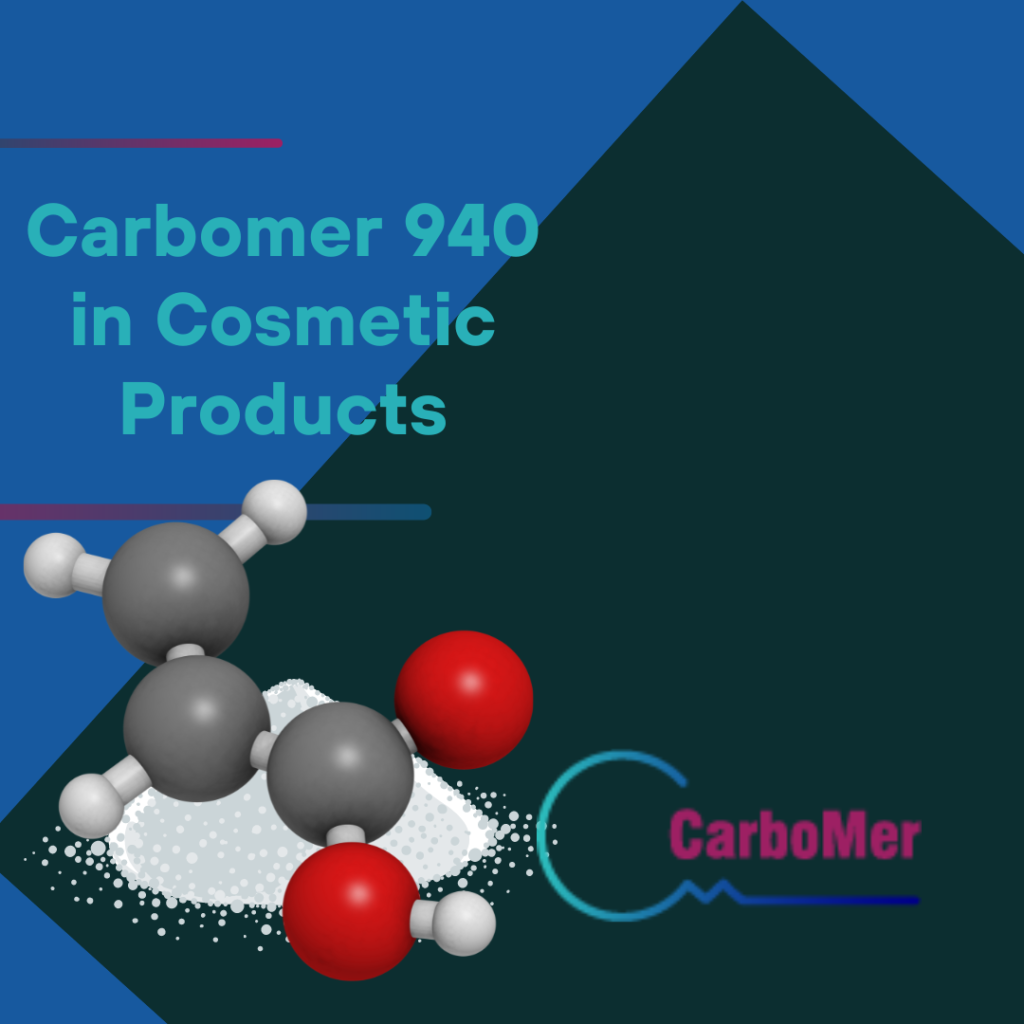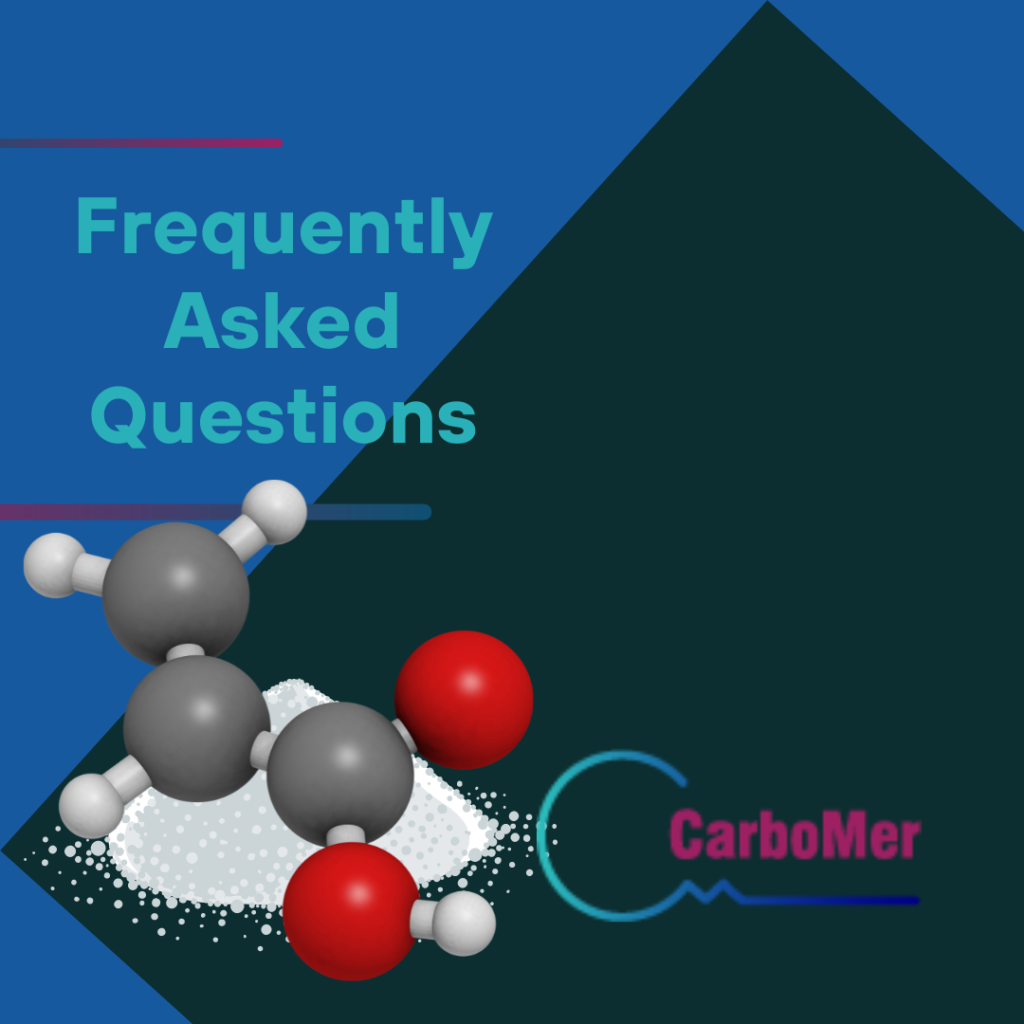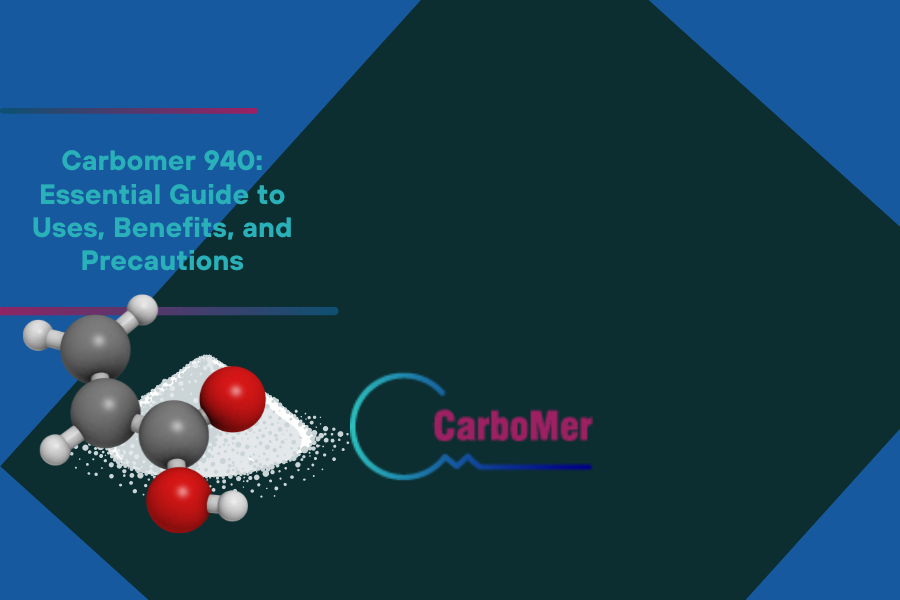Carbomer 940: it’s what gives your lotions, gels, and topical medications their reliably smooth textures. This guide unpacks the science behind Carbomer 940, a vital player in product formulation, and shares essential handling practices to maximize its benefits safely.
Key Takeaways
- Carbomer 940 is a polyvinyl carboxy polymer used for thickening, gelling, and stabilizing in cosmetics and pharmaceuticals, due to its ability to absorb water, retain moisture, and enhance stability and viscosity of products.
- In the cosmetics industry, Carbomer 940 facilitates the formation of clear gels, ensures product consistency and spreadability, and stabilizes emulsions, making it a key ingredient in many skin and hair care products.
- Pharmaceutical uses of Carbomer 940 include bioadhesive applications for eye drops and controlled release medication delivery systems, leveraging its mucoadhesive properties and ability to form gel matrices for drug encapsulation.

Understanding Carbomer 940
In practical terms, Carbomer 940 is a polyvinyl carboxy polymer derived from acrylic acid. The secret behind its remarkable properties lies in its intricate structure. The high molecular weight polymer structure is achieved through a process known as cross-linking, with allyl ethers of pentaerythritol. This cross-linking is what gives Carbomer 940 its unique thickening and stabilizing abilities.
Its primary use lies in cosmetic and pharmaceutical formulations. Whether it’s a skin moisturizer, a hair gel, or an ophthalmic medication, chances are, Carbomer 940 is playing a crucial role in ensuring the product’s consistency and effectiveness.
Poly(acrylic acid) and Cross-linking
The backbone of Carbomer 940 is Poly(acrylic acid) (PAA). This is then cross-linked using agents such as allyl ethers of pentaerythritol to create a three-dimensional network. This process transforms the liquid acrylic acid into a flexible gel form, through the cross-linking of poly(acrylic acid) chains.
In aqueous solutions, Carbomer 940 forms a gel-like network, thanks to its cross-linked polymer structure. It’s this unique formation that gives Carbomer 940 its stability and viscosity properties, making it an invaluable ingredient in various formulations.
Properties and Functions
One of the most impressive properties of Carbomer 940 is its ability to:
- absorb and retain large amounts of water
- result in significant swelling
- increase the viscosity of the formulation
- produce highly viscous gels even at low concentrations ranging from 0.1 to 1.0 percent.
Carbomer 940 has several properties that make it a valuable ingredient in gels and creams:
- It provides the desired texture
- It maintains stability in the presence of suspended particles
- It improves the texture of a product
- It binds other ingredients together to prevent separation
These properties make Carbomer 940 an essential ingredient in many cosmetic and skincare products.
The gelling strength and viscosity of Carbomer 940 are influenced by the formulation’s pH level, which ideally should be maintained between 5.0 to 10.0 for optimal gel integrity and effectiveness.

Carbomer 940 in Cosmetic Products
With its ability to absorb and retain water, Carbomer 940 is an integral part of many cosmetic products. So, when you slather on that moisturizing lotion or apply that shiny lipstick, you have this versatile polymer to thank for the product’s texture and consistency.
In the world of hair care, Carbomer 940 steps in to regulate stickiness and consistency, aiding in the product’s spreadability and compatibility with other ingredients. Whether it’s shaping your hair with gel or washing it with shampoo, Carbomer 940 is hard at work, ensuring that your hair care products deliver the results you desire.
Clear Gels and Formulations
Carbomer 940 truly shines when it comes to creating clear cosmetic gels, including hair gels. In an industry where product appearance can be as important as performance, Carbomer 940 serves as an effective gelling agent, ensuring both clarity and a smooth consistency.
Upon neutralization, Carbomer 940 forms stable gels that retain clarity over a wide pH range, beneficial for various cosmetic products. Emulsions and Thickening
When it comes to the personal care industry, Carbomer 940 earns its place as a viscosity enhancer and thickening agent. It enhances the texture of products and provides a pleasing glide during application. But that’s not all! Carbomer 940 also stabilizes emulsions by maintaining the mixture of water and oil components, ensuring consistent product quality.
As a suspension agent, it effectively disperses insoluble solids within liquids—crucial for the formulation of stable suspensions and emulsions. The gel-forming ability and flow resistance of Carbomer 940, determined by its degree of cross-linking, are vital for the physical properties of topical formulations. Even in surfactant-free formulations, Carbomer 940 shines, creating stable creams without traditional surfactants, thus enhancing rheological properties.

Pharmaceutical Applications
Beyond the cosmetic world, Carbomer 940 has found significant applications in various industries, including the pharmaceutical industry. Thanks to its bioadhesive properties, it enhances the adherence of medications to skin and mucous membranes, promoting efficacy.
The versatility of Carbomer 940 makes it suitable for use in multiple drug administration routes, including:
- Oral
- Ophthalmic
- Intestinal
- Nasal
- Vaginal
- Rectal
- Transdermal gel systems
As an effective permanent suspension agent for insoluble ingredients, it is essential in creating stable oral suspensions and topical medications.
Eye Drops and Medications
When it comes to eye drops and medications, Carbomer 940 is a game-changer. It enhances the viscosity and mucoadhesion of ophthalmic gel formulations, improving the retention and bioavailability of drugs in the eye.
Used as a bioadhesive polymer in gel eye drops, Carbomer 940 offers the following benefits for ophthalmic treatments:
- Increases corneal retention
- Enhances drug bioavailability
- Allows for prolonged drug release
- Provides an enhanced therapeutic effect
Eye drops containing Carbomer 940 quickly transition to a gel upon contact with tear fluid, ensuring prolonged drug release and maximizing the therapeutic effect.
Carbomer 940 is also utilized in in situ gelling systems for eye medications, enhancing drug residence time in the eye.
Controlled Release Technologies
Carbomer 940 also finds its place in the world of controlled release technologies. Its cross-linked polymeric structure allows for the encapsulation of drugs and controlled release through diffusion.
From gel-core bacterial microcompartments, carboxysomes for ocular drug delivery to Carbomer 940-based hydrogels for intravitreal injections, the possibilities are vast. The bioadhesive properties of Carbomer 940 enable the creation of mucoadhesive formulations that adhere to mucosal tissues for controlled and targeted medication release.
Furthermore, Carbomer 940 in bead formulations adjusts drug release rates and encapsulation efficiency, significantly influencing bead structure and compactness.

Preparing and Using Carbomer 940
Activating Carbomer 940 for gelling involves a two-stage process, starting with dispersion and hydration, followed by neutralization of the solution, resulting in a gel formed. Supplied as a light, low-density powder, Carbomer 940 may cause dusting issues and can form agglomerates when incorporated into water.
Effective dispersion of Carbomer 940 can be achieved using a high-shear mixer, ensuring it reaches a consistent particle size and full hydration. The pH of a Carbomer 940 formulation influences its thickening and stabilizing abilities, necessitating careful adjustments with neutralizing agents like sodium hydroxide or triethanolamine.
Sodium Hydroxide and Triethanolamine
Neutralizing Carbomer 940 is a crucial step in its preparation. This involves adjusting the solution’s pH from acidic to a neutral or slightly alkaline range to induce gelation.
The addition of sodium hydroxide or triethanolamine as neutralizing agents causes Carbomer particles to swell and thicken the solution into a gel. The ratio of Carbomer 940 to neutralizing agents is critical for achieving the desired gel viscosity and consistency. These agents must be added slowly and mixed continuously to ensure uniformity throughout the Carbomer 940 gel and to avoid gel spots due to localized high pH.
Mixing and Hydration
The process of creating a powerful vortex that draws Carbomer 940 white powder into the liquid, and forcing the mixture through the mixer workhead’s slots, is essential for breaking down agglomerates and achieving a smooth consistency.
Allowing sufficient time for the Carbomer 940 to fully swell post-mixing is also crucial to ensure that the polymer is fully hydrated. Complete hydration of Carbomer 940 can take up to 24 hours, depending on the specific formulation and mixing conditions involved.

Safety and Precautions
While Carbomer 940 is generally considered safe for use in cosmetics and skincare products at approved concentrations, it’s always important to be aware of potential side effects. Some individuals with sensitive skin may experience skin irritation or allergic reactions to products containing Carbomer 940. Overuse of cosmetics containing Carbomer 940 can also result in a heavy or tacky feeling on the skin.
Eye irritation is a potential side effect if products with Carbomer 940 accidentally come into contact with the eyes. It’s always recommended to conduct a patch test when trying a new product containing Carbomer 940 to check for adverse reactions.
Skin Sensitivity and Irritation
Skin sensitivity is a crucial factor to consider when using products containing Carbomer 940. Individuals might experience mild irritation or redness, especially if they have sensitive skin. Allergic reactions to Carbomer 940 are uncommon but possible and may include swelling, hives, rash, or itching. Consumers with preexisting skin sensitivities are advised to consult with a dermatologist before using products containing Carbomer 940.
Proper handling of Carbomer 940 requires well-ventilated conditions and appropriate protective clothing to prevent skin and eye irritation.
Storage and Handling
Proper storage and handling are key to maintaining the efficacy of Carbomer 940. Here are some guidelines to follow:
- Store Carbomer 940 in a closed container
- Keep it in a dry place at room temperature
- Avoid exposure to high temperatures and direct sunlight, as they can degrade the quality of Carbomer 940.
Carbomer 940 containers should be stored tightly closed in a dry, cool, and well-ventilated place and kept away from incompatible materials and foodstuff. It’s also important to handle Carbomer 940 with non-sparking tools and take measures to prevent dust and aerosol formation to avoid fire caused by electrostatic discharge steam.
Personal protective equipment such as tightly fitting safety goggles, fire/flame resistant and impervious clothing, and gloves should be worn when handling Carbomer 940.

Innovations and Future Applications
The future of Carbomer 940 seems promising with ongoing research and innovations shaping its applications. Starch-based delivery systems incorporated with Carbomer 940 have been developed to provide controlled release and targeted delivery of active compounds.
Silicone delivery systems employing Carbomer 940 have shown improved performance in personal care products with enhanced sensory properties. The exploration of Carbomer 940 for bioadhesive drug delivery systems due to its high viscosity and adhesion properties is also an exciting development.
Starch-Based and Silicone Delivery Systems
Carbomer 940 is being integrated into starch-based delivery systems to enhance their performance, particularly by improving texture and consistency. Within these systems, Carbomer 940 serves as a thickening agent, often in combination with other thickeners like maltodextrin and corn starch.
Silicone delivery systems in personal care also utilize Carbomer 940 to stabilize formulations and facilitate the effective delivery of active ingredients. In these silicone-based systems, Carbomer 940 assists in providing controlled release and targeted delivery of active compounds through its thickening capability and ability to work in conjunction with silicone.

Summary
In conclusion, Carbomer 940 is a versatile and powerful ingredient that enhances the effectiveness and quality of a wide array of cosmetic and pharmaceutical products. Its unique properties, from creating clear gels to its role in controlled release technologies, make it an invaluable asset in these industries. With ongoing research and innovations, the potential of Carbomer 940 is only set to grow, paving the way for more advanced and effective products in the future.

Frequently Asked Questions
Is Carbomer 940 safe for skin?
Yes, carbomer 940 is safe for skin and has a long history of safe use in various cosmetic and pharmaceutical products.
Is Carbomer hazardous?
Carbomer is generally considered safe and well tolerated when used in cosmetic and pharmaceutical products. It has a long history of safe use in various personal care items.
What does Carbomer do to the skin?
Carbomer can improve skin health by enhancing moisturization, providing even application of active ingredients, and preventing irritation and allergies. It also helps in formulation stability and can be used to create customized formulations for different skin types.
What is Carbomer 940 used for?
Carbomer 940 is used as a viscosity enhancer, gelling agent, or suspension agent in various products that require clarity or specific viscosity characteristics.
What is Carbomer 940?
Carbomer 940 is a synthetic polymer used in cosmetic and pharmaceutical products for its thickening and stabilizing properties. It is primarily derived from acrylic acid.

